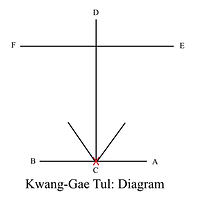TKD Study Info for Students Test Preparation
Further Reading
(External Links)
Student Oath of Taekwon-Do
1. I shall observe the tenets of Taekwon-Do
Courtesy, Integrity, Perseverance, Self-Control, Indomitable Spirit
2. I shall respect the Instructor and seniors
3. I shall never misuse Taekwon-Do
4. I shall be a champion of freedom and justice
5. I shall build a more peaceful world
Taekwon-Do Colour Belts
& ITF Patterns Meanings
*The belt and pattern meanings listed on this page are quoted from the Encyclopedia of Taekwon-Do, written by General Choi Hong-Hi
White Belt
White signifies innocence as that of the beginning student who has no previous knowledge of Taekwon-Do.
Chon-Ji tul:
Chon-Ji means literally "The Heaven, The Earth." It is, in the Orient, interpreted as the creation of the world or the beginning of human history, therefor it is the initial pattern played by the beginner. This pattern consists of two similar parts, one to represent the Heaven, and the other the Earth.
Chon-Ji has 19 Movements
It begins from Parallel Ready Stance
Chon-Ji is the 1st pattern in Taekwon-Do

Yellow Belt
Yellow signifies the Earth from which a plant sprouts and takes root as the foundation of Taekwon-Do is being laid.
Dan-Gun tul:
Dan-Gun is named after the holy Dan-Gun, the legendary founder of Korea in the year 2333 B.C.
Dan-Gun has 21 Movements
It begins from Parallel Ready Stance
Dan-Gun is the 2nd pattern in Taekwon-Do

Do-San tul:
Do-San is the pseudonym of the patriot Ahn Chang-Ho (1878-1938). The 24 Movements represent his entire life, which he devoted to furthering the education of Korea and its independence movement.
Do-San has 24 Movements
It begins from Parallel Ready Stance
Do-San is the 3rd pattern in Taekwon-Do

Green Belt
Green signifies the plant's growth as Taekwon-Do skills begin to develop.
Won-Hyo tul:
Won-Hyo was the noted monk who introduced Buddhism to Silla Dynasty in the year 686 A.D.
Won-Hyo has 28 Movements
It begins from Close Ready Stance A
Won-Hyo is the 4th pattern in Taekwon-Do

Yul-Gok tul:
Yul-Gok was the pseudonym of a great philosopher and scholar, Yi I (1536-1584), nicknamed the Confucious of Korea. The 38 movements of this pattern refer to his birthplace on 38° latitude, and the diagram represents "scholar".
Yul-Gok has 38 Movements
It begins from Parallel Ready Stance
Yul-Gok is the 5th pattern in Taekwon-Do

Blue Belt
Blue signifies the Heaven toward which the plant matures into a towering tree as training in Taekwon-Do progresses.
Joong-Gun tul:
Joong Gun is named after the patriot Ahn Joong-Gun who assassinated Hiro-Bumi Ito, the first Japanese governor-general of Korea, known as the man who played the leading part in the Korea-Japan merger. There are 32 movements in this pattern to represent Mr. Ahn's age when he was executed at Lui-Shung prison (1910).
Joong-Gun has 32 Movements
It begins from Close Ready Stance B
Joong-Gun is the 6th pattern in Taekwon-Do

Toi-Gye tul:
Toi-Gye is the pen name of noted scholar Yi Hwang (16th century), an authority on neo-Confucianism. The 37 movements of the pattern refer to 37° latitude, the diagram represents "scholar".
Toi-Gye has 37 Movements
It begins from Close Ready Stance B
Toi-Gye is the 7th pattern in Taekwon-Do

Red Belt
Red signifies danger, cautioning the student to exercise control and warning the opponent to stay away.
Hwa-Rang tul:
Hwa-Rang is named after the Hwa-Rang youth group which originated in the Silla Dynasty in the early 7th century. The 29 movements refer to the 29th Infantry Division, where Taekwon-Do developed into maturity.
Hwa-Rang has 29 Movements
It begins from Close Ready Stance C
Hwa-Rang is the 8th pattern in Taekwon-Do

Choong-Moo tul:
Choong-Moo was the name given to the great Admiral Yi Soon-Sin of the Yi Dynasty. He was reputed to have invented the first armoured battleship (Kobukson) in 1592, which is said to be the precursor of the present day submarine. The reason why this pattern ends in a left hand attack is to symbolize his regrettable death, having no chance to show his unrestrained potentiality checked by the forced reservation of his loyalty to the king.
Choong-Moo has 30 Movements
It begins from Parallel Ready Stance
Choong-Moo is the 9th pattern in Taekwon-Do

Black Belt I Degree
Black, opposite of White, therefore signifying maturity and proficiency in Taekwon-Do. It also indicates the wearer's imperviousness to darkness and fear.
Kwang-Gae Tul:
Kwang-Gae is named after the famous Gwang-Gae-Toh-Wang, the 19th King of the Koguryo Dynasty, who regained all the lost territories including the greater part of Manchuria. The diagram represents the expansion and recovery of lost territory. The 39 movements refer to the first two figures of 391 A.D., the year he came to the throne.
Kwang-Gae has 39 Movements
It begins from Parallel Ready Stance with Heaven Hand
Kwang-Gae is the 10th pattern in Taekwon-Do

Po-Eun Tul:
Po-Eun is the pseudonym of a loyal subject, Chong Mong-Chu (1400) who was a famous poet, and whose poem "I would not serve a second master though I might be crucified a hundred times" is known to every Korean. He was also a pioneer in the field of physics. The diagram represents his unerring loyalty to the king and country towards the end of the Koryo Dynasty.
Po-Eun has 36 Movements
It begins from Parallel Ready Stance with Heaven Hand
Po-Eun is the 11th pattern in Taekwon-Do

Ge-Baek Tul:
Ge-Baek is named after Ge-Baek, a great general in the Baek Je Dynasty (660 A.D.). The diagram represents his severe and strict military discipline.
Ge-Baek has 44 Movements
It begins from Parallel Ready Stance
Ge-Baek is the 12th pattern in Taekwon-Do


